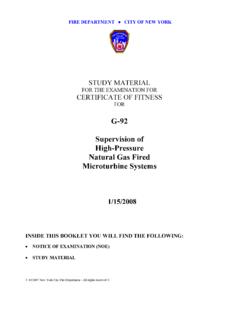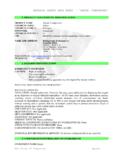Transcription of WELDING, CUTTING, BRAZING, COMPRESSED AIR & GAS
1 Steingass Mechanical Contracting, Inc. 754 Progress Drive Medina, Ohio 44256 (330) 725-6090 welding , cutting , brazing , COMPRESSED AIR & GAS CYLINDERS Hot Work 2 PROGRAM ELEMENTS 1) COMPRESSED Gas Cylinders 2) Gas welding and cutting 3) Arc welding and cutting 4) Fire Prevention 5) Personal Protective Equipment 6) Ventilation and Protection in welding , cutting and Heating 7) Signs and Labels 8) Special Conditions and Applications 9) Maintenance 10) Training 3 INTRODUCTION COMPRESSED GAS CYLINDERS, welding AND cutting REGULATORY AUTHORITY FOR IMPLEMENTATION OF COMPRESSED GAS CYLINDERS, welding AND cutting The Occupational Safety and Health Act under 29 CFR 1926 Subpart J, establishes requirements relating to COMPRESSED Gas Cylinders, welding and cutting . In response to the regulatory mandate, Steingass Mechanical Contracting, Inc. has developed and will maintain the COMPRESSED Gas Cylinders, welding and cutting Program to provide proper and safe procedures for all applicable employees.
2 PURPOSE This document is primarily intended to establish guidelines to be followed whenever any employee(s) work with COMPRESSED gas cylinders and/or welding and cutting equipment. In addition, it is intended to outline uniform methods of protecting, training, operation and maintenance practices to ensure these are communicated to and understood by the affected employees. RESPONSIBILITY Steingass Mechanical Contracting, Inc. shall instruct all appropriate employees in the safety significance of the COMPRESSED Gas Cylinders, welding and cutting Program. In addition, Steingass Mechanical Contracting, Inc. considers these requirements to be of critical importance in helping to ensure that the applicable provisions of the COMPRESSED Gas Cylinders, welding and cutting Program are known, understood, and strictly adhered to by all employees. 4 It shall be the responsibility of the Safety Director to continually monitor the COMPRESSED Gas Cylinders, welding and cutting Program to ensure that all requirements of these procedures are being followed and that any deviations or inadequacies are corrected.
3 Prior to any welding and/or cutting is permitted the area shall be inspected and a hot work permit is completed in writing granting authorization of welding and cutting operations. See Appendix A Hot Work Permit cutting and welding . COMPRESSED GAS CYLINDERS PROCEDURES Transporting, Moving & Storing of COMPRESSED Gas Cylinders 1. At all times when the cylinder is not in use, the valve protection caps must be in place and secure. When in use the proper use of gauges is required. 2. When cylinders are to be hoisted, they must be secured on a cradle, sling-board or pallet. No cylinders will be hoisted or transported by means of magnets or choker slings. 3. All cylinders must be moved by tilting and rolling them on their bottom edges. At no time should they be intentionally dropped, struck, or permitted to strike each other. 4. During transportation of cylinders in vehicles, the cylinders must be secured in a vertical position.
4 5. At no time will the valve protection caps be used for lifting cylinders from one vertical position to another. Bars must not be used under valve protection caps to pry cylinders loose when frozen. ONLY WARM WATER can be used to thaw cylinders. 6. Unless the cylinders are in a special carrier intended for cylinders, regulators must be removed and valve protection caps put in place before cylinders are moved. 7. A special carrier intended for cylinders, chain or other steadying device must be used to keep cylinders from being knocked over while in use. 8. The cylinder valve must be closed when: work is finished; cylinders are empty or when cylinders are moved. 9. All COMPRESSED gas cylinders must be stored & secured in an UPRIGHT position at all times. 10. The acetylene and oxygen cylinders must be stored apart from one another by a minimum distance of 20 feet or by a 5-foot high non-combustible barrier. 5 Placing Cylinders 1.
5 Cylinders must be kept far enough away from the actual welding or cutting operations so that sparks, hot slag or flame will not reach them. If this is not possible, fire resistant shields must be provided. 2. All cylinders must be placed where they cannot become part of an electrical circuit. It is prohibited to strike an electrode against a cylinder to strike an arc. 3. Fuel gas cylinders must be placed with valve end up whenever they are in use. The fuel gas cylinder must not be placed in any location where they would be subjected to open flame, hot metal or other sources of artificial heat. 4. AT NO TIME WILL CYLINDERS CONTAINING OXYGEN, ACETYLENE OR OTHER FUEL GAS BE PERMITTED INTO CONFINED SPACES. Treatment of Cylinders 1. No cylinder will be permitted, whether full or empty, to be used as rollers or supports. 2. It is strictly forbidden to mix gases or refill a cylinder. The supplier of the cylinder must only do this. 3.
6 THE CONTENTS OF ANY CYLINDER SHOULD ONLY BE USED FOR PURPOSES INTENDED BY THE SUPPLIER. 4. At no time during work operations are employees permitted to use a damaged or defective cylinder. 6 7 GAS welding AND cutting 1. Before a regulator to a cylinder valve is connected, the valve will be opened slightly and closed immediately. This action is termed cracking and is intended to clear the valve of dust or dirt that might otherwise enter the regulator. The employee cracking the valve will stand to one side of the outlet, not in front of it. The valve of a fuel gas cylinder will not be cracked where the gas could reach welding work, sparks, flame, or other possible sources of ignition. 2. The cylinder valve will always be opened slowly to prevent damage to the regulator. A special wrench will be left in position on the stem of the valve, while the cylinder is in use, so that the fuel gas flow can be shut off quickly in case of an emergency.
7 In manifolded or coupled cylinder, a special wrench will always be available for immediate use. 3. Nothing is permitted to be placed on top of a fuel gas cylinder when in use that may damage the safety device or interfere with the quick closing of the valve in an emergency. 4. Before a regulator is removed from a cylinder valve, the cylinder will always be closed and the gas released from the regulator. 5. In the event a leak is found around the valve stem, the valve will be closed and the gland nut tightened. If this does not stop the leak; the use of the cylinder will be discontinued, properly tagged and immediately removed from the work area. In the event fuel gas should leak from the cylinder valve, rather than from the valve stem and the gas cannot be shut off, the cylinder will be properly tagged and removed from the work area. 8 Fuel Gas and Oxygen Manifolds 1. Fuel gas and oxygen manifolds will bear the name of the substance it contains.
8 Letters at least 1-inch high will either be painted on the manifold or on a sign that can be permanently attached. 2. Fuel gas and oxygen manifolds will be placed in safe, well ventilated and accessible locations. AT NO TIME SHOULD FUEL GAS AND OXYGEN BE PERMITTED WITHIN ENCLOSED SPACES. 3. Manifold hose connections, including both ends of the supply hose that lead to the manifold, will be such that the hose cannot be interchanged between fuel gas and oxygen manifolds and supply header connections. ADAPTERS MUST NOT BE USED TO PERMIT THE INTERCHANGE OF HOSE. Hose connections will be kept free of grease and oil. 4. When not in use, all manifold and header hose connections will be capped. 5. Placing anything on top of a manifold, which will damage the manifold or interfere with the quick closing of the valves, is not permitted. 9 Hoses 1. Fuel hoses and oxygen hoses must be easily distinguishable from each other.
9 The contrast may be made by different colors or by surface characteristics readily distinguishable by the sense of touch. Oxygen and fuel gas hoses will not be interchangeable. Any signal hose having more than one gas passage will not be used. 2. In the event that parallel sections of oxygen and fuel gas hose are taped together, not more than 4 inches out of 12 inches shall be covered by tape in order not to interfere with distinguishing colors. 3. All hoses in use, carrying acetylene, oxygen, and natural or manufactured fuel gas or any gas or substance, which may ignite or enter into combustion, will be inspected at the beginning of each working shift. Any defective hose will be removed from service. 4. All hose couplings will be of the type that cannot be unlocked or disconnected by means of a straight pull without rotary motion. 5. All hoses, cables and other equipment will be kept clear of passageways, ladders and stairs. 10 Torches 1.
10 All clogged torch tip openings will be cleaned with suitable cleaning wires, drills or other devices designed for this purpose. 2. Torches in use will be inspected at the beginning of each work shift for leaking at shutoff valves, hose couplings and tip connections. Any defective torch will not be used. 3. Torches will be lighted with friction lighter or any other approved devices. AT NO TIME IS IT PERMITTED TO LIGHT A TORCH WITH MATCHES OR OTHER HOT WORK. 4. All torches will be equipped with flashback arrestors. 11 ARC welding AND cutting Manual Electrode Holders 1. Only manual electrode holders which are specifically designed for arc welding and cutting , and are of a capacity capable of safely handling the maximum rated current required by the electrodes, will be used. 2. Any current-carrying parts passing through the portion of the holder, which the arc welder or cutter grips in his/her hand, and the outer surfaces of the jaws of the holder, will be fully insulated against the maximum voltage, encountered to ground.







